
My lievito madre (videos)
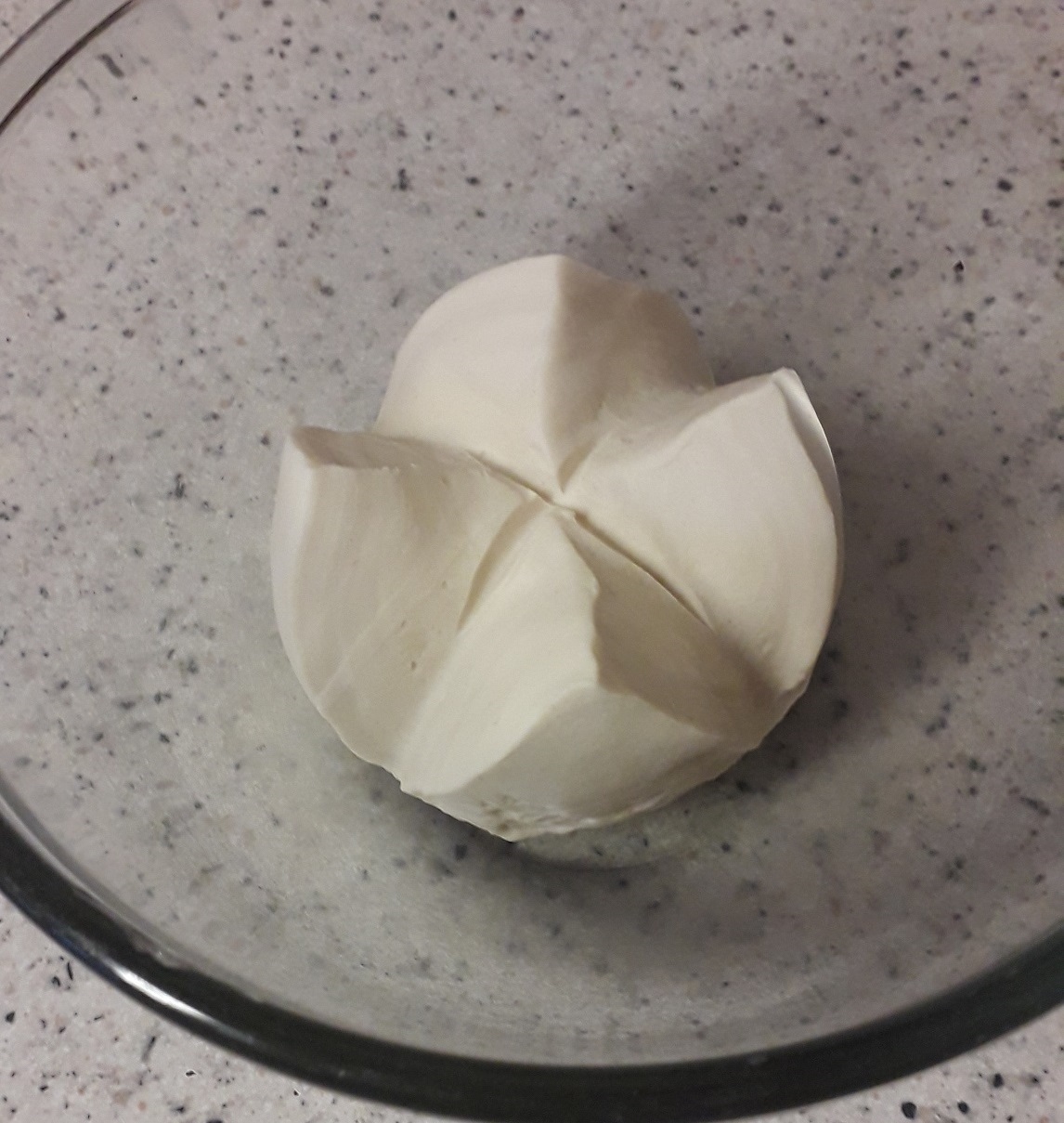
Spontaneously I documented the maintenance of my starter.
Please excuse any background noise and the appearance of my unkempt face.


Spontaneously I documented the maintenance of my starter.
Please excuse any background noise and the appearance of my unkempt face.

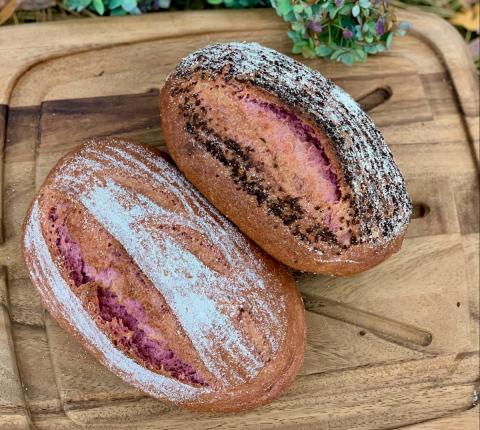
I'm really loving purple bread! I've made a similar bread a few months ago, but this time I decided to also add freshly ground purple corn. I also used Kamut instead of the previously used Spelt.
I was very happy with how this turned out. The crumb was semi-open, nice and soft and flavorful. This one is a keeper and worth trying if you dare.
Here are the Zip files for the above BreadStorm files.
Levain Directions
Mix all the levain ingredients together for about 1 minute and cover with plastic wrap. Let it sit at room temperature for around 7-8 hours or until the starter has doubled. I used my proofer set at 83 degrees and it took about 4 hours. You can use it immediately in the final dough or let it sit in your refrigerator overnight.
Main Dough Procedure
Mix the flours and the sweet potato with 90% of the water for about 1 minute. Let the rough dough sit for about 20 minutes to an hour. Next add the levain, olive oil, salt and the balance of the water and mix on low for 5 minutes. Remove the dough from your bowl and place it in a lightly oiled bowl or work surface and do several stretch and folds. Let it rest covered for 10-15 minutes and then do another stretch and fold. Let it rest another 10-15 minutes and do one additional stretch and fold. After a total of 2 hours place your covered bowl in the refrigerator and let it rest for 12 to 24 hours. (Since I used my proofer I only let the dough sit out for 1.5 hours before refrigerating).
When you are ready to bake remove the bowl from the refrigerator and let it set out at room temperature still covered for 1.5 to 2 hours. Remove the dough and shape as desired.
The dough will take 1.5 to 2 hours depending on your room temperature and will only rise about 1/3 it's size at most. Let the dough dictate when it is read to bake not the clock.
Around 45 minutes before ready to bake, pre-heat your oven to 540 degrees F. and prepare it for steam. I have a heavy-duty baking pan on the bottom rack of my oven with 1 baking stone on above the pan and one on the top shelf. I pour 1 cup of boiling water in the pan right after I place the dough in the oven.
Right before you are ready to put them in the oven, score as desired and then add 1 cup of boiling water to your steam pan or follow your own steam procedure.
Lower the temperature to 450 degrees. Bake for 25-35 minutes until the crust is nice and brown and the internal temperature of the bread is 205 degrees.
Take the bread out of the oven when done and let it cool on a bakers rack before for at least 2 hours before eating.
Below is the nice moist and colorful crumb.
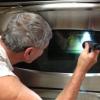
A TFL user know as "Del" graciously offered this formula with instructions. As far as I know, Del’s original post is no longer on the forum. Del lived in Hawaii near a bakery that was famous for this bread. His instructions are elaborate and very detailed, but if you follow his instructions you are certain to succeed. Please don't let the lengthy instructions dissuade you. You may have to improvise on one or more techniques. For example, I used the dough hook instead of the paddle for the final mix. IMO, the formula his formula is perfected. The bread is out of sight...
Below is a screen shot of the spreadsheet detailing the baker's percentages and weights in grams.
They make killer hamburger and hot dog buns.
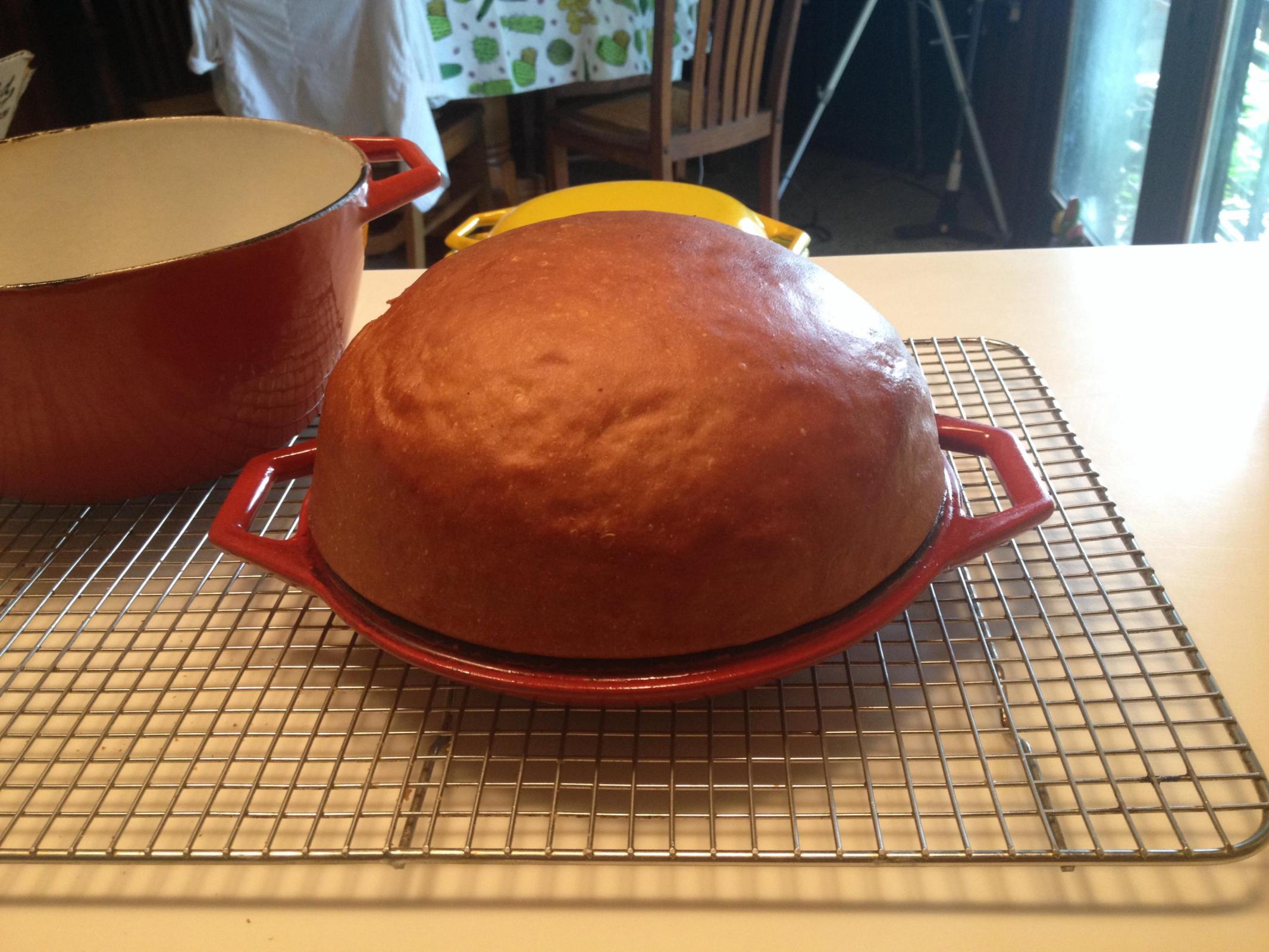

Hawaiian Style Portuguese Sweet Bread
Instructions copied from Del
1. Yeast - You will need to get osmotolerant yeast. I use SAF-Instant in the Gold Package.
2. You will need plastic bags for these loaves after they finish cooling. It is really important to bag your loaves to prevent drying out the bread. (Hydration pre-baked is around 67 %.)
3. The weights given will make three loaves of 20oz. (569 grams) each pre-baked. This comes out to around 1 lb. baked per loaf. The whole process takes 3 1/2 hours start till eating.
4. KitchenAid (KA) Mixer speeds are given as actual speeds --- like the first speed is when it comes on, and the second speed is what follows etc. I don't use the KA's speed numbers printed on the mixer because they don't make sense to me. There are eight "real" speeds on my KA mixer. It was difficult to mix in my KitchenAid. I plan to use an Ankarsrum next time. Ankarsrum worked very well. The KA worked but it labored too much for me.
1 egg (optional for egg wash) set out on counter to come to room temperature
113 grams Unsalted Butter (15%)
210 grams White Sugar (28%)
If you want to egg wash, then leave an egg out on the counter for later on.
In your mixer bowl, cream the butter and sugar together with a paddle attachment at the 3rd KA speed until about doubled in volume. I just keep my mixer running constantly while I proceed thru this recipe. Also I am lazy and just take my bulk butter out of the refrig and plunk it in the mixer chopped up and ice cold. The mixer bowl will start to sweat on the outside (condensation) but this won't harm anything. If you decide to warm up your refrigerated cold butter, the butter must be bendable (yes BENDABLE like clay) in order to cream with sugar correctly. If your butter is soft then it simply won't cream right. Using it straight out of the refrig insures things go right as the butter warms up while creaming with sugar. The Ankarsrum didn’t cream well with the roller and scraper, so I’m using the whisk now.
285 grams BOILING water (38%) I boil more water than needed then measure the use that amount or pre-boiled
38 grams Instant Dry Milk (5%)
38 grams Instant Mash Potato Flakes (5%)
In a small sauce pan, boil the water. Once it is rolling boiling, add in the dry milk and whisk. THEN remove from heat and whisk in the instant mash potato flakes till everything is nicely blended.
218 grams Whole Eggs, Ice Cold straight from refrigerator (29%) - about 4 or 5 medium eggs
10 grams Vanilla Extract (1.3%) or 2 Teaspoon
5 grams total Lemon/Orange Extract (0.6%) Optional but then again so is Caviar in Life...
(The extracts come out to 2 teaspoon of Lemon only, or 1 teaspoon each of Lemon/Orange extract, or 2 teaspoon of Orange only --whatever you got available)
Hand whisk the ice cold eggs into the hot potato/milk mixture. The coldness of the eggs should bring down the temperature of the mixture to a safe level for your yeast additions later on. No need to temper eggs. Whisk in the extracts. Set aside. You can also wish in the creamed sugar at this time.
300 grams BREAD flour (40%)
15 grams Osmotolerant Yeast like SAF GOLD (2%) --this is around 1 ½ Teaspoon of yeast
Stop your mixer that is running creaming the butter and sugar. By this time, it should have doubled in volume and be almost pure white in color. Tare and then add in your flour and then put the SAF GOLD yeast on top. Using the same paddle attachment, mix at a lower 2nd KA speed till well blended. Now, while the mixer is still on, add in the now lukewarm (if it's not, then wait for it to cool down some) mixture from your saucepan (milk/potato/egg/extract mix) all at once into the mixer bowl. It will all be extremely soupy. Slowly increase the speed of the KA mixer to the highest speed that will not splatter the soupy mixture out of the bowl. You will be slowly increasing the speed as you see the gluten developing. Overall mixing time is 5 minutes. When I do it, I can almost get to the 8th KA speed by the time 5 minutes is up.
This is my lazy man's "sponge" method. Again, your gluten development will allow you to increase the speed of the KA mixer higher and higher and this is so important!
450 grams BREAD flour (60%)
7 grams Nutmeg, finely ground (1%) Optional. Comes out to 1 Tablespoon. Or just skip adding nutmeg altogether.)
Place the flour and optional finely ground nutmeg on top of your lazy man's sponge you just created. Now using the detached paddle attachment that you have in your hand, work this flour into the soupy mixture completely. If you don't do this then you risk splattering flour all over your kitchen when you first turn on the mixer! Place paddle attachment back on mixer and then knead for 5 minutes at the 3th KA speed. Yes, use a paddle attachment, not the kneading hook at this point (faster). NOTE; I now use an Ankarsrum to mix and it does fine with scraper & roller.
7 grams salt non-ionized (1%) --about 1 Tablespoon
Odd as it sounds, NOW ADD THE SALT on top of the dough. Scrape down the sides of the mixer bowl and off the paddle with a spatula. Replace paddle with a dough hook and knead for 5 minutes at a slower 2nd KA speed
Place the dough in a large plastic bowl and use your hands to briefly knead into a nice ball (boule) in the bowl. If you've done everything right, the dough WILL NOT STICK to the plastic bowl at all.
Cover and let rest for 1 hour in a warm place till about doubled in size. Then divide into 3 equal sizes of around 19 ounces each (540 grams) or (makes great rolls or buns @ 2 oz. each and hoagies @ 3.5 oz or 100g) and then pre-shape into loose balls. Bench rest for 20 minutes.
Preheat oven to 350 degree F. (177 degree C.) And setup steam at this time
Final shape into taut balls/boules and place each into an oil sprayed 9 inch pie pan tin. Cover each with an overturned large plastic bowl for about one hour (check at 40 minutes dough may over proof) until dough is just touching the sides of the 9 inch pie pan (dough may be more than doubled in size at this point).
Optional Step:
Take your room temperature egg and whisk completely. Egg wash the tops of the balls/boules being extremely careful not to let any egg wash drip into the pie pan itself as this will bake into a hard unappetizing mess. I use my hands to do the egg wash. Again do not drip any egg wash into the pie pan!
Once oven is heated correctly and the dough is just touching all sides of its 9 inch pie pan, place the pans on the upper rack in your oven (baking on lower racks may burn the bottoms). I’ve been baking at 335° convection for 38 minutes culminating with a bread temperature of 190°. I also used the middle rack. Do not dry out by over cooking. You are looking for a graduated colored crust with dark brown at the top and lightening to almost a pale yellow near the bottom of the loaf next to the pie pan. This graduated coloring has good eye appeal and also insures that the bread itself is not over baked. Because of the high sugar content watch the bread for over browning.
Cool in pie pans for at least 45 minutes then remove round loaf from pie pan. Immediately place in a plastic bag and seal lightly. I just turn under my overly long bag beneath my loaf. If you notice excessive condensation inside the bag, simply open up the bag until it evaporates then reseal immediately.
It is important that you don't let the loaves just sit out. You need to bag the breads to insure a pillow softness texture to the breads that Hawaiian Style Portuguese Sweet Bread is known for. After ripping off a piece of bread (really best way to eat it), replace loaf back in bag and seal to retain moisture and freshness.
You will be amazed at how these loaves turn out. Only use SAF GOLD yeast. Bag the cooled bread.
Ingredients
1 egg (optional for egg wash)
113 grams Unsalted Butter (15%)
210 grams White Sugar (28%)
285 grams BOILING water (38%)
38 grams Instant Dry Milk (5%)
38 grams Instant Mash Potato Flakes (5%)
218 grams Whole Eggs, Ice Cold straight from Refrig (29%) Approximately 4 – 5 medium eggs
10 grams Vanilla Extract (1.3%) or 1 Teaspoon
5 grams Lemon extract (.66%) or 1/2 Teaspoon
5 grams Orange extract (.66%) or 1/2 Teaspoon
300 grams BREAD flour (40%)
16 grams Osmotolerant Yeast like SAF GOLD (2%) --this is around 2 Tablespoon of yeast
450 grams BREAD flour (60%)
7 grams Nutmeg, finely ground (1%) Optional, comes out to 1 Teaspoon
8 grams salt non-ionized (1%) --equals 1.41 Teaspoon
Baker’s Percentages
Unsalted Butter 15 %
White Sugar 28 %
BOILING water 38 %
Instant Dry Milk 5 %
Instant Mash Potato Flakes 5 %
Whole Eggs 29 %
Vanilla Extract 1.3 %
Lemon extract .66 %
Lemon extract .66 %
BREAD flour 40 %
SAF GOLD 2 %
BREAD flour 60 %
Nutmeg 1 %
salt non-ionized 1 %
Total Percentage = 226.62%
| Yield | |
|---|---|
| Prep time | |
| Cooking time | |
| Total time |

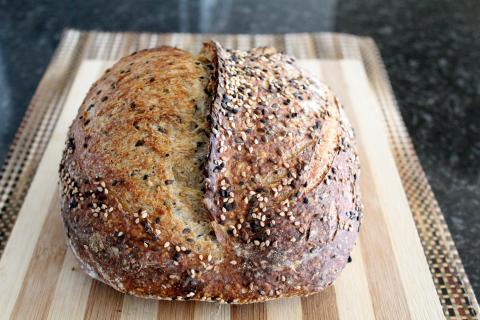
So, you know when your choices are 1) wake up super early to get your loaves in the oven and have fresh bread or 2) don’t bother baking because your day is really busy and go without the bread… Clearly, the right answer is to wake up and bake. Am I right? Well anyway, that’s what happened to me this weekend and here is the consequence of my choice.
One (mostly) white SD

...and one seeded SD loaf
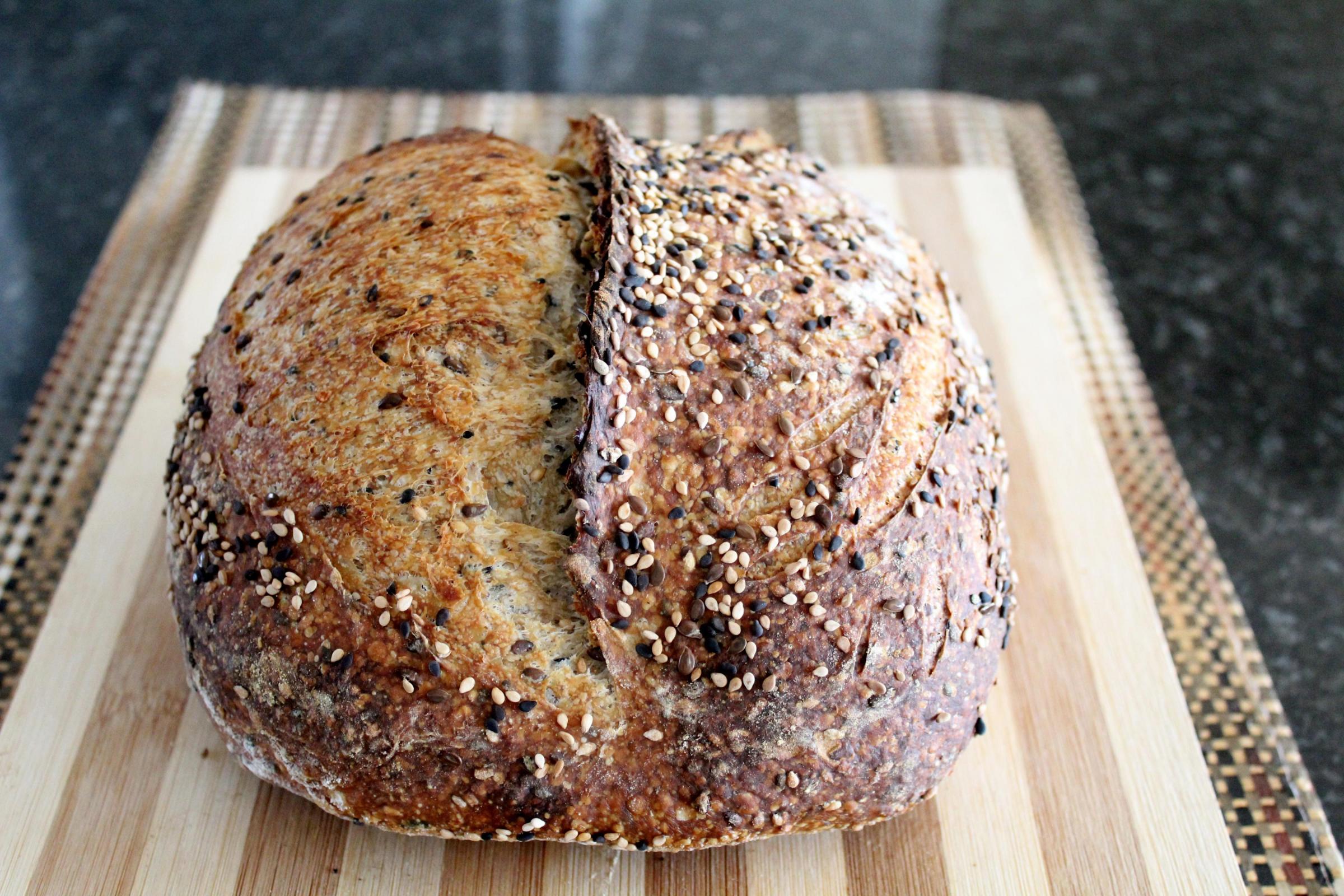
The white loaf is the pretty much the same as my previous post except I upped the hydration a tiny bit from 76% to just shy of 79% and dropped the prefermented flour % from 12% to 11% (yes, 1% is important to me!! LOL!!)
This loaf has become my little project and I must say, I prefer the result I got this time. The crumb is noticeably softer and melty in mouth. Yum… I let this one have a much longer shaped proof (3.5 hours instead of 1.25hours) and retarded it for 8 hours instead of 14hours.

I'm happy with the oven spring on this one,

Crumb shot...
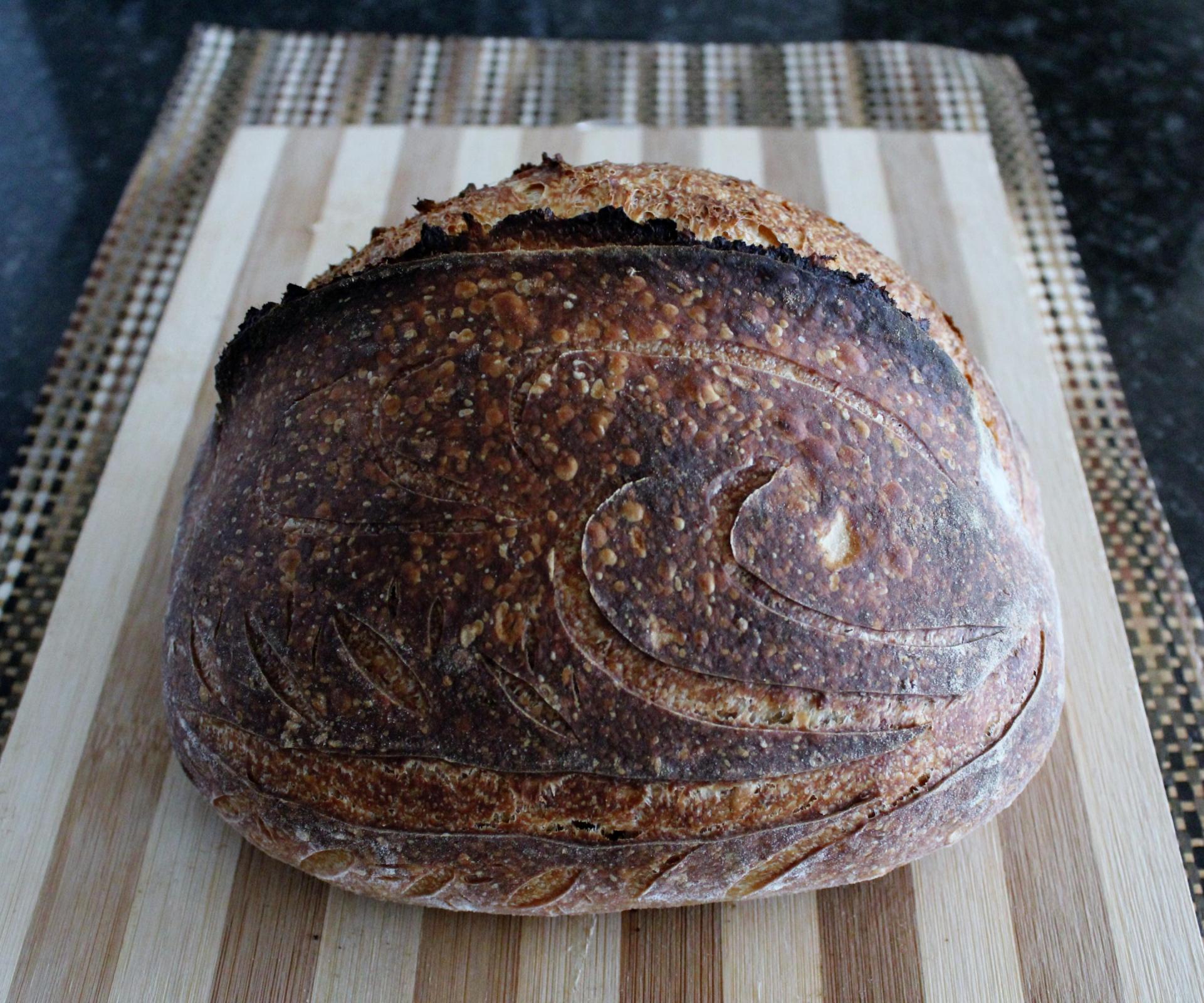
Still playing with my scoring :)
The next loaf was a seeded loaf… nothing fancy, just a mix of white and black sesame seeds and linseeds. I’ve made a seeded SD loaf before and I really enjoyed it but I thought that the seeds sucked a lot of moisture out of my dough. So this time I toasted the seeds and soaked them in boiling water overnight before putting them in the dough. I put just enough water so that it would all be absorbed, I didn’t want extra water to end up in my dough.
Here is the formula and method:
| Weight (g) | Final dough | % | |
Levain (80% hydration) | 90 |
|
| |
Water | 296 | 336 | 80% | |
|
|
|
| |
Flour | 370 | 420 | 100% | |
Unbleached white bread flour | 330 | 330 | 79% | |
Whole wheat flour | 40 | 80 | 19% | |
Rye flour |
| 10 | 2% | |
|
|
|
| |
Salt | 9 | 9 | 2% | |
|
|
|
| |
Seeds | 80 | 80 | 20% | |
Sesame seeds (black) | 15 | 15 | 4% | |
Sesame seeds (white) | 40 | 40 | 10% | |
Linseeds | 25 | 25 | 6% | |
|
|
|
| |
Total dough weight | 845 | 845 |
|
1. 1 stage 12 hour levain build. 20 g NMNF rye starter plus 45g whole wheat flour and 36g water.
2. “Pre mix” the flour and water for the dough the night before mixing, chill in the fridge for a few hours and leave to come to room temperature overnight.
Toast the seeds and soak in 55g of boiling water.
3. Add the salt, levain and seeds to the dough and mix.
I spent about 50 mins mixing the dough initially (about 2 -3 mins on, 10 mins rest x 4) and then did 3 set of stretch and folds, not quite hourly but they were done within the first 3.5 hours of the bulk fermentation. Then another 5 hours bulk fermentation (yes, things were slow because its cold here)
4. Pre shape and let the dough rest for 30mins.
5. Shape and let the dough sit in the basket for 3.5hours before refrigerating for 8 hours.
6. Baked at 250 dC for 20mins with steam and then at 230 dC for another 25mins.
Result:
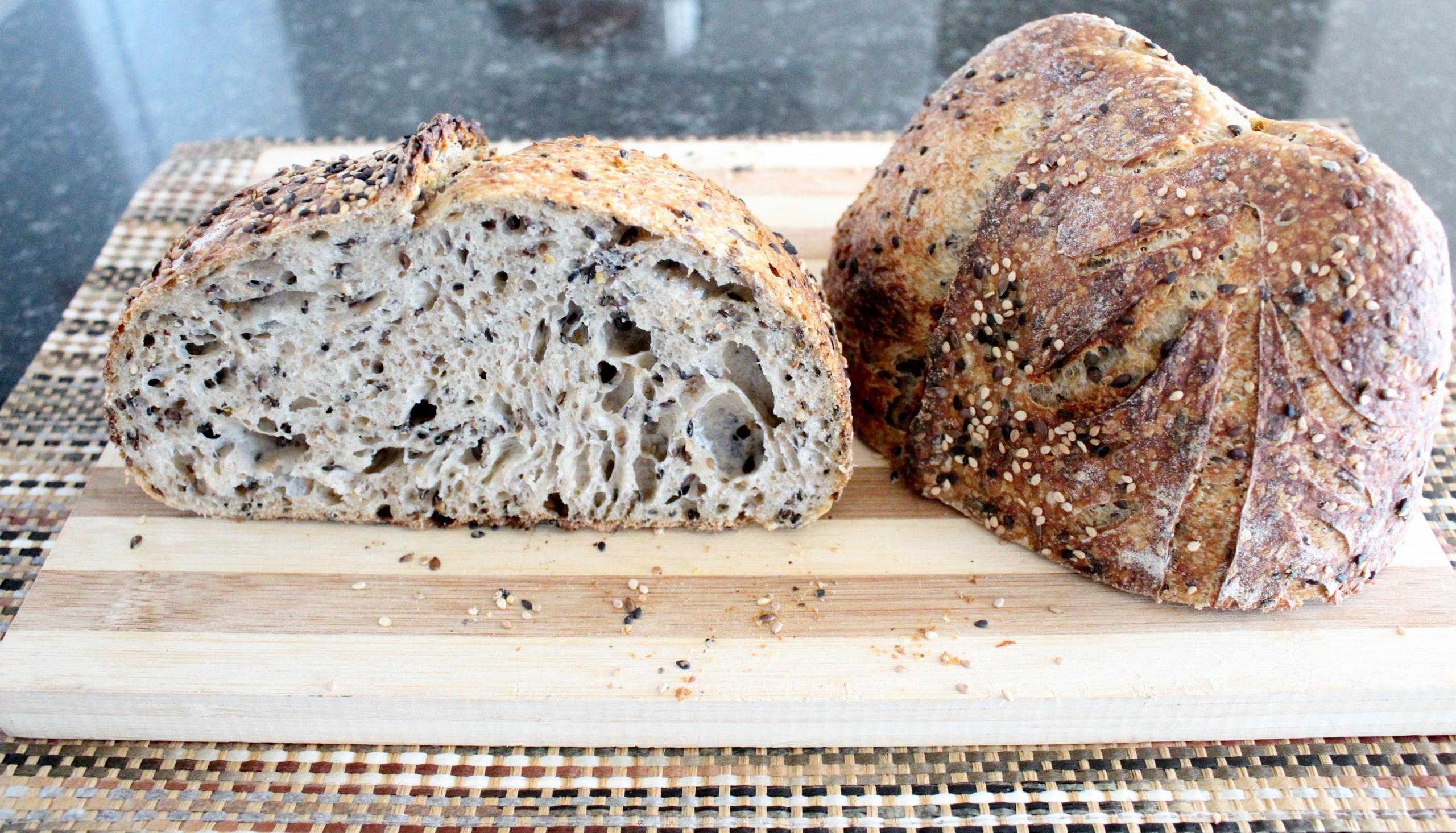
Slicing this loaf was amazing! The aroma of the seeds was just so good…I was worried that I didn't have enough seeds in the dough, but I think I got just the right amount.

Soaking the seeds was a good idea, the crumb is nice a moist because the seeds didn’t steal as much water from the rest of the dough.

I hope everyone has a great week! Happy baking friends :)
Ru


The title is a mouthful I know.
But wow this bread might be my new favorite.
I made a video showing how I made these loaves. It's pretty straight to the point, if anyone is interested in watching. Don't mind my pajamas lol.
if not, pictures coming right up:





This bread came out so dark and rich....wow. Yes, new favorite for sure.
Happy baking!


Recently was scrolling through the pages of the very old cookbook The Kentucky Housewife and decided to give a go at the potato rolls. After playing around with the recipe and making some tweaks to my method I have a recipe that I think is worth posting! Here are a few pictures from the process, too.
The levain build. I was skeptical of how the potato mash would fair overnight but it was beautiful!
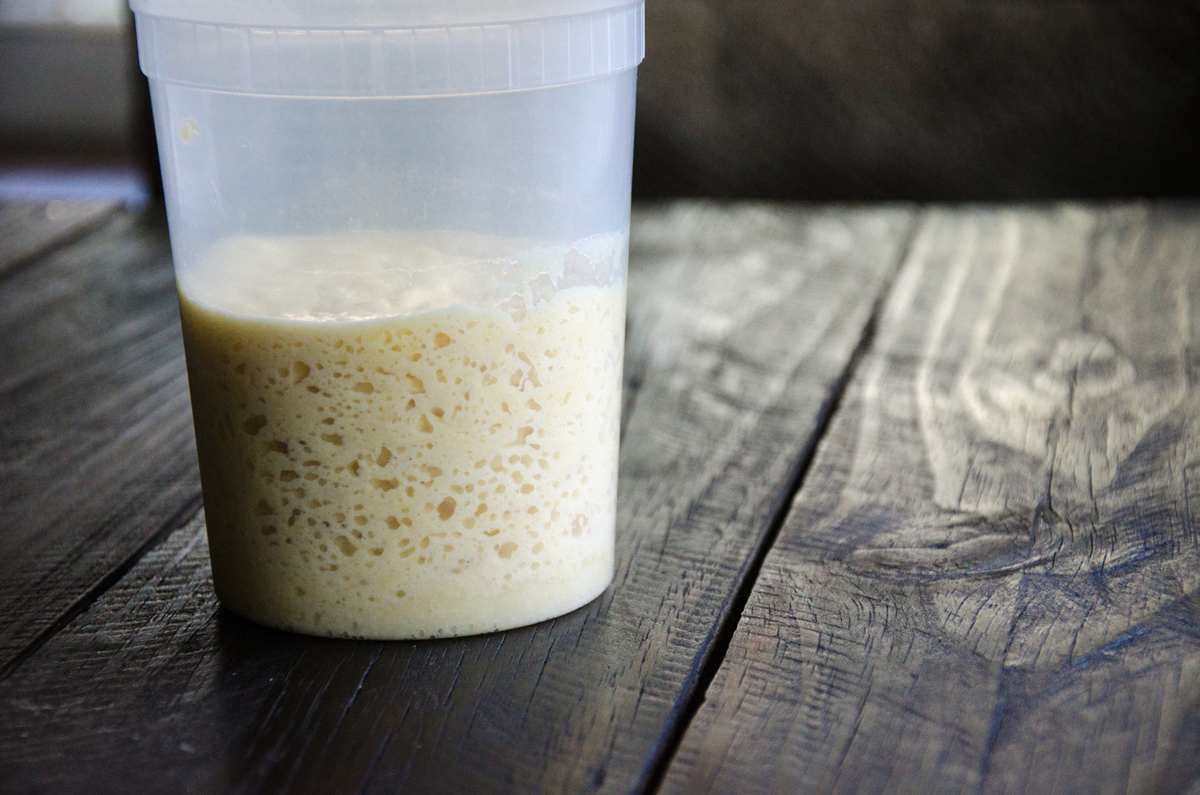
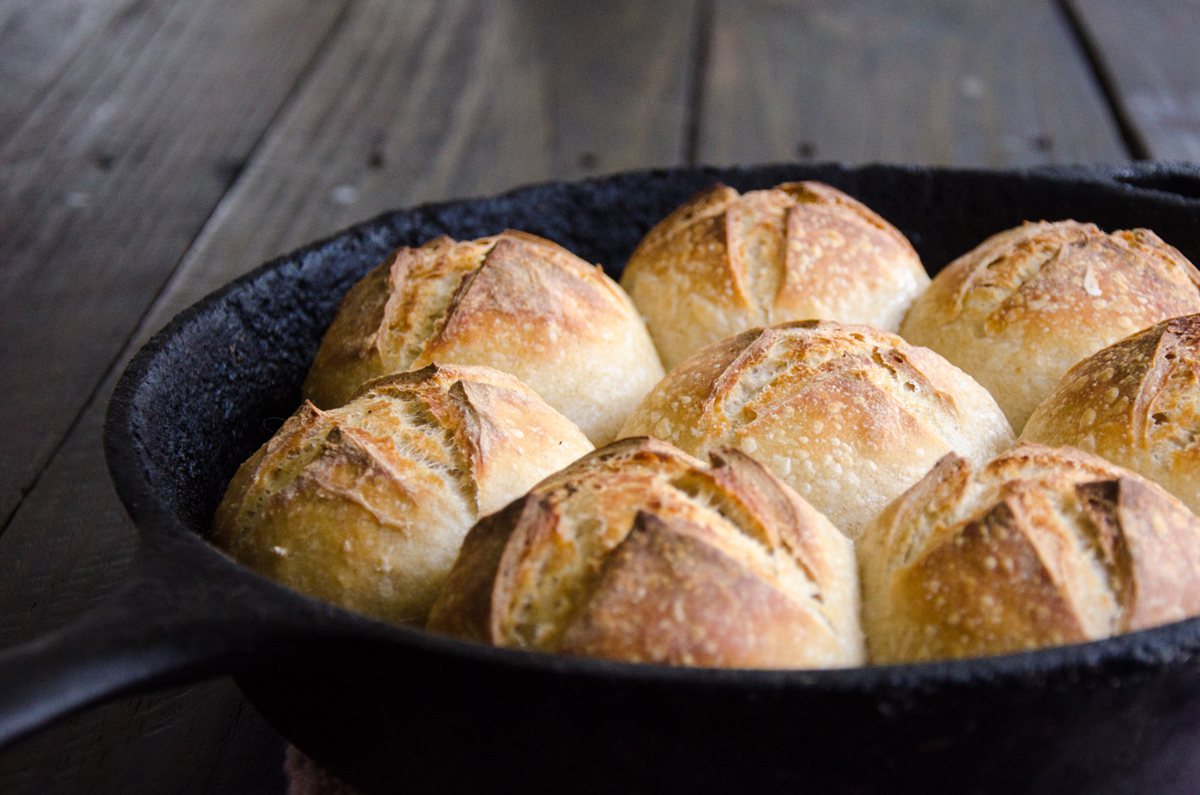

| Yield | |
|---|---|
| Source | https://archive.org/stream/kentuckyhousewif00whit#page/14/mode/2up |
| Prep time | 13 hours |
| Cooking time | 35 minutes |
| Total time | 13 hours, 35 minutes |

How can you tell when bulk fermentation is done? I haven't been able to find anything conclusive regarding this. Most recipes give a time window, but I have no idea what this is based off. How much the dough has risen seems to be a measuring point, but then again I believe this depends on how often you fold? What is the end goal for bulk fermentation phase?
Ken Forkish for example says "dough has tripled", but I've seen some recipes where only 20-30% rise is expected.

For as long as I've been an attendee at TFL University I continually see postings galore for both the Vermont SD and the Norwich SD. Which, in an odd way, had me keep my distance from them both. Until today. Mr. Hamelman's Vermont SD is the first, foundational entry in his book's entire section of levain based breads, preceding even the venerable Pain au Levain entries. I'd skipped over it before.
But I had an urge to get back to building one of his ubiquitous 125% hydration bread flour levains after my romance, still underway, with my bastardized rye version of the same. So now what to bake, what to bake? Well, here I am. As with other breads that I wish to make into baguettes, I did some diligent searching for evidence of this being made before as baguettes. This time there were a very few instances where someone in the distant past did so (drat!). I was on board anyway. Stubby baguettes are my thang, if you haven't yet figured that out.
This is a 90% bread flour, 10% rye flour dough with a 125% hydration bread flour levain. Clocking in at 65% overall hydration it leans toward the more rubbery side of things during the French Folds. 15% of the flour is in the levain. Next time out I'll give these loaves another shade of dark before venting them.
375 x 4 baguettes.
and the crumb:
Here is the formula at 1000g, and the way that I do it:
| Vermont Sourdough | |||||||||
| Jeffrey Hamelman | |||||||||
| Total Flour | |||||||||
| Total Dough Weight (g) | 1000 | Prefermented | 15.00% | ||||||
| Total Formula | Levain | Final Dough | |||||||
| Ingredients | % | Grams | % | Grams | Ingredients | Grams | |||
| Total Flour | 100.00% | 599.2 | 100.00% | 89.9 | Final Flour | 509.3 | |||
| Bread Flour | 90.00% | 539.2 | 100.00% | 89.9 | Bread Flour | 449.4 | |||
| Rye | 10.00% | 59.9 | 0.00% | 0.0 | Rye | 59.9 | |||
| Water | 65.00% | 389.5 | 125% | 112.3 | Water | 277.1 | |||
| Salt | 1.90% | 11.4 | Salt | 11.4 | |||||
| Starter | 3.00% | 18.0 | 20% | 18.0 | |||||
| Levain | 202.2 | ||||||||
| Totals | 166.90% | 1000.0 | 245% | 220.2 | 1000.0 | ||||
| 2 stage liquid levain build | |||||||||
| Stage 1 | |||||||||
| Bread Flour | 44.9 | ||||||||
| Rye | 0.0 | ||||||||
| Water | 56.2 | ||||||||
| Starter | 18.0 | ||||||||
| Stage 2 | |||||||||
| Bread Flour | 44.9 | ||||||||
| Rye | 0.0 | ||||||||
| Water | 56.2 | ||||||||
| Total | 220.2 | ||||||||
This dough is very workable at the shaping stage.
Caveats & notes:
Darth Baker

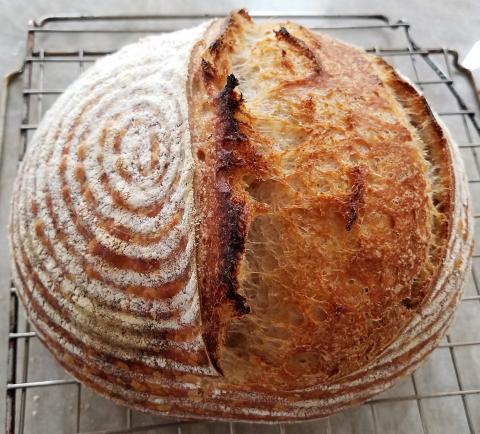
So, my scale finally arrived, and I got a banneton for proofing as well. I've been experimenting a bit, and I think I finally got it. Since all the folks here were so helpful, I figured I could contribute by sharing my results. Would really love to hear your comments too! You can see the final product in the photo above.
The recipe:
In the morning, take starter from the fridge and feed it 1:1:1, i.e. equal amounts of starter, water, and flour. Cover and let it sit in a warm place for 6-8 hrs.
Ingredients:
Levain (100% hydration) - 50g starter, 50g warm water, 50g KA WW four, mixed in the morning and put in warm place.
Water - 300g
Flour - 450g KA BF
Salt - 10g
Baker's math:
Flour - 100%
Water - 71.5%
Salt - 1.9%
Mix everything, except salt, until all flour is absorbed. Cover and let stand for 60 min, then add salt and mix for 4-5 min. I use stand mixer, but you can use anything you like.
Place the dough in a lightly oiled bowl, cover, let rest for 30 min. Take it out on a lightly-floured surface and stretch and fold from 4 sides, then put it back in the bowl. Repeat rest and stretch and fold 3 times (4 times total, cover during rest). BF for 2 hrs. On lightly-floured surface pre-shape, let rest 10-15 min, then final shape.
Flour the banneton, and the surface of the dough (lightly), place the dough into the banneton and cold proof overnight (10-12 hrs). Next morning, take the dough out of the fridge and let warm up on the counter for 1.5-2 hrs. (EDIT: I later found this step to be completely unnecessary; you can bake straight from the fridge, and is scores this way easier too!). Meanwhile, preheat oven to 500F, then drop the temp to 475F. I baked at first under a "dome". I have this old cast-aluminum pot, which I preheat in the oven and then invert and cover the dough with it to create hot and steamy environment, similar to a Dutch oven or Cloche. It looks like this:
I am baking right on a cookie sheet, lightly covered with corn meal to prevent dough sticking. Take the dough out of the banneton, dust off any excess flour, and score the bread. I scored at a shallow angle, trying to create an "ear". I think I succeeded.
Bake under the dome for 20 min at 475F, then drop temp to 460F and bake uncovered for 20 min more, rotating once in the middle. I waited for about 2 hrs before slicing the loaf, and I must admit that was torture! :-) (EDIT: It's actually better to wait much longer, 3-4 hrs). The crumb looks fine, although I would prefer it a bit more airy. The taste was wonderful, and the crust was the crunchiest I ever achieved!
Hope this helps someone too!

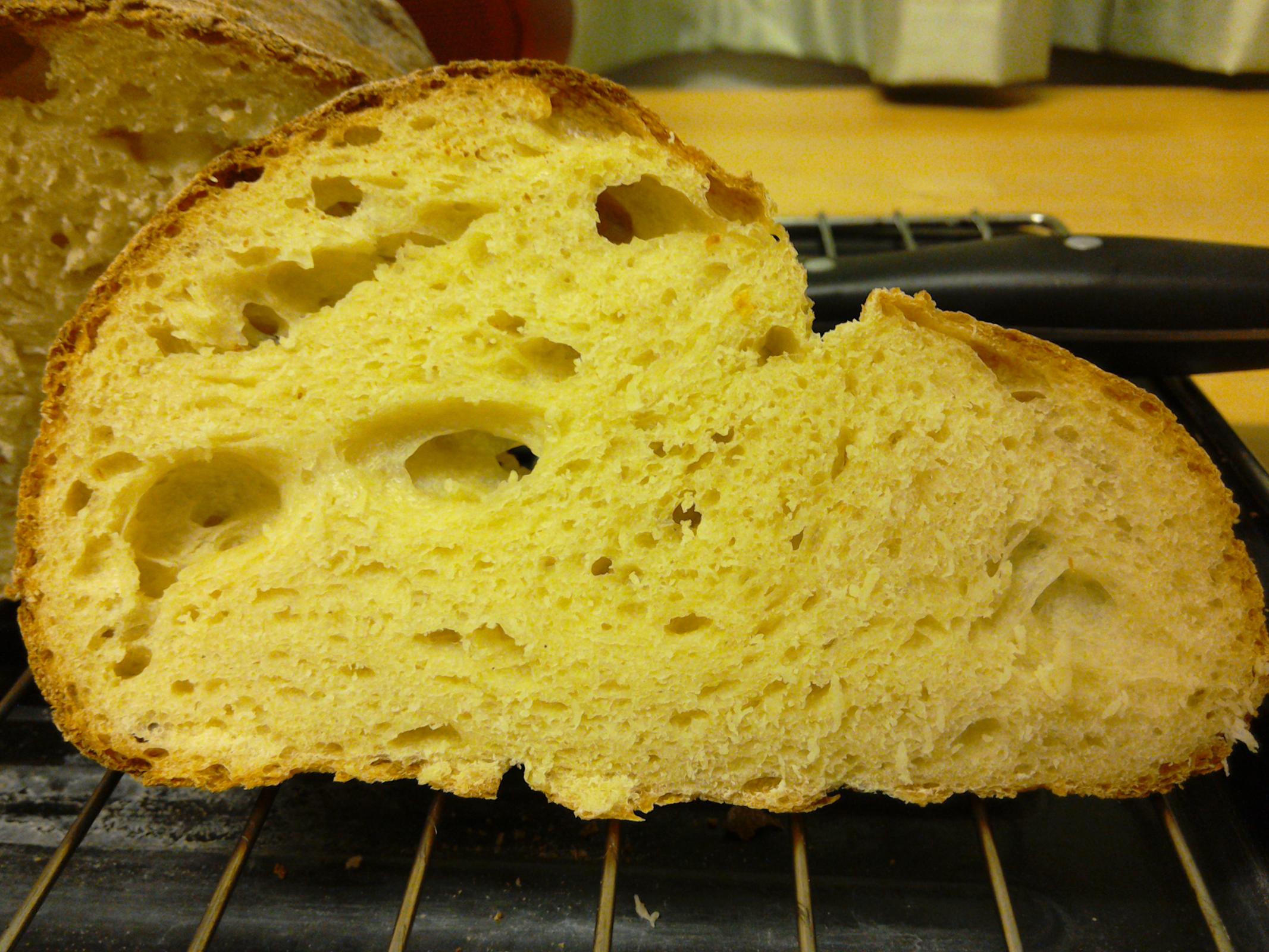
500g durum flour
330g warm water
12.5g salt
100g starter @ 66% hydration
Convert your starter by taking off a little and feeding it durum flour + 66% water. After a few feeds continue onto the following final feed...
12g starter + 40g warm water + 60g durum flour
Allow to mature for 12-14 hours then continue onto the recipe.
1. Autolyse 500g durum flour + 330g warm water for one hour.
2. Add 100g starter and fold a few times then sprinkle 12.5g salt over the dough then squeeze and fold till fully incorporated. Done this way to keep them separate. Rest for 10 minutes.
3. Knead the dough for 20 minutes till gluten is fully formed and the dough is silky smooth.
4. Bulk Ferment at room temperature for about 4 hours (until doubled)
5. Pre-shape into a round and bench rest for 30 minutes.
6. Pre-heat the oven to 230C.
7. Final Shape and bench rest for 15 min.
8. Bake until hard dark crust forms. About 30-40 minutes.
9. Leave to cool.
10. Enjoy!
Best tasting one yet. Lots of flavour.
IMPORTANT EDIT: while i did get a lovely bread i was following the DOP to some extent. For the bulk ferment i did find room for my own interpretation as the DOP specifies "atleast" 90min, hence the 4 hours i did. But the shaping and final proofing seemed very specific. Gaetano has just informed me that this should be non specific too. Please see his comment below... http://www.thefreshloaf.com/comment/377611#comment-377611